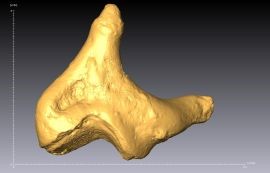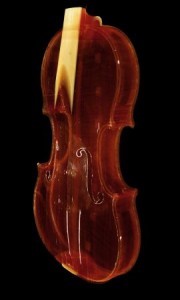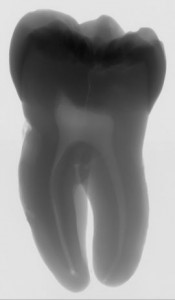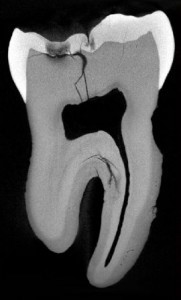Vienna microCT-Lab (Faculty of Life Sciences)

Auditory ossicle (incus) of a fossil primate, approx. 3.10mm x 3.26mm, scan-resolution 4.7µm, reconstructed resolution 5µm
How can I get a micro CT-Scan?
We are able to scan objects of just a few millimetres in size (see ossicle of a fossil primate to the right) but also those with a diameter up to 250mm. The objects can also be substantially longer (up to 500mm) than the base area because we can produce spiral-scans (see violine to the right). The duration of a scan depends on the object’s properties because we have to tune the recording parameters (voltage, amperage, and exposition time) accordingly to achieve optimal quality. Important is particularly the density and the size of the object. In usual cases the scanning time ranges between 2 to 4 hours. Spiral scans require considerably more time, roughly between 6 to 12 hours.

Historic violin, scan-resolution 72.6µm, reconstructed resolution 100µm
Our VISCOM X8060 produces raw data in the form of TIFF-images. Typically, there are 1,440 single images, thus one X-ray image per quarter degree. Depending on the length of the object, for spiral scans there are 5,000-8,000 single images. We deliver these raw data, or on demand, also computed volume data. This reconstruction of slices (as you know them from medical scanners) is facilitated on an extremely powerful computer.
The process takes between 1 to 8 hours. The time needed is depending on the data volume which is reconstructed. We can zoom into particular regions and thus just produce slices for a Region of Interest (ROI).
Resulting data files are more easily manageable because the full data set would be approx. 20GB in size which can exceed the limits of standard PCs. During this process we can also tune the resolution and adapt it to your needs.

One of the 1,440 individual X-rays (raw data) of a human molar, scan-resolution 9.77µm

One of the 510 slices (volume data) of the same tooth, reconstructed resolution 25µm
For external scans we offer three options:
- Payment of the incurred hours (€ 90,- per scanning hour, € 90,- per hour sample handling, € 60,- per hour on the reconstruction PC).
- Collaboration in a scientific publication, in case there is also intellectual exchange (e.g. measurements, segmentations, etc., see www.virtual-anthropology.com)
- Exchange of data, if you have interesting data for us, e.g. other µCT-scans of hominins, apes, etc. that you can share with us.
What you should know about your probe before contacting us:
- How large is your object? (LxWxH in mm)
- Which region of the object is relevant? (Quite often it is only a subarea of the object that is interesting. We can zoom on this region of interest)
- Can the object be fixated? (We must avoid motion artefacts. Therefore, the object itself has to be rigid and we must be able to immovably mount it on the scanning platform)
- Can we scan multiple objects at once? (For several smaller objects, so called “revolver scans” are possible)
- What is the desired spatial resolution? (How large is the smallest detail of the object that you need to recognize?)
- Do you have the possibility to work with 3D volume data? (Do you have access to high-performance computers and appropriate software?)
Please send your inquiries per email to gerhard.weber@univie.ac.at
